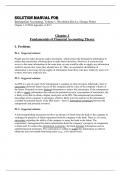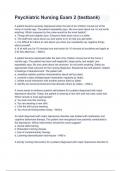Solution Manual For Intermediate Accounting, Volume 1, 5th edition Kin Lo, George Fisher Chapter 1 -10 With Appendix (A B C ) Chapter 1 Fundamentals o f Financial Accounting Theory I. Problems P1-1. Suggested solution: People need to make decisions under uncertainty, which creates the demand for information to reduce that uncertainty, allowing them to make better decisions. However, if everyone had access to the same information at the same time, no one would be able to supply any information useful to anyone else (since they already have it). Thus, an asymmetr ic distribution of information is necessary for the supply of information from those who have relatively more of it to those who have relatively less. P1-2. Suggested solution: An IPO is a sale of a part of the entrepreneur’s company to other investors. Inherently, there is uncertainty about the future success of this company and the value of the company’s shares in the future. Potential investors demand information to reduce this uncertainty. If the entrepreneur is able to supply information that reduces the potential investor’s perceptions of uncertainty, she is likely to be able to obtain a higher stock price in the IPO. The entrepreneur has intimate knowledge of her company’s operations, which is likely to be far superior to th e information available to potential buyers of the IPO shares —there is information asymmetry between the entrepreneur and potential investors. P1-3. Suggested solution: A borrowing/lending transaction involves an advance of funds from the bank to the com pany in exchange for promises of future repayment from the company to the bank. There is, of course, uncertainty regarding the ability of the company to repay the bank in the future. The corporation’s management has better information about the company’s p rospects in comparison to bank staff. To reduce this information asymmetry , the bank demands information such as audited financial statements. The corporation is willing to supply this information in order to obtain the most favourable borrowing terms (e.g ., a low interest rate). P1-4. Suggested solution: Adverse selection Moral hazard Hidden action or information? Hidden information Hidden action Information about past, present, or future? Past and present Future Associated with the market for ―lemons‖ or insurance deductibles? Market for lemons Insurance deductibles Mitigation of information asymmetry involves risk sharing or full disclosure? Full disclosure Risk sharing Most closely associated with investment decisions or compliance with contractual terms? Investment decisions Compliance with contractual terms Creates demand for provision of relevant or reliable information? Relevant information Reliable information P1-5. Suggested solution: The managers within companies have an information advantage over outside investors. This adverse selection causes investors to be sceptical of investing in the company, unless management provides information to alleviate that scepticism. If management withholds information, investors will rati onally price the company as a ―lemon.‖ To avoid this negative outcome, management’s best response is to voluntarily provide information to investors. P1-6. Suggested solution: Signalling must be costly to be credible because a costless signal can be sent by anyone. A signal that can be sent by anyone has no value because such ―cheap talk‖ does not help differentiate one party from another. Thus, the signal should not believed —it is not credible. Since signalling must be costly to be credible, a company that can credibly communicate information through other more cost-effective means would avoid costly signalling. Therefore, if there are no other cost-effective means to communic ate a particular type of information, the company could choose to use costly signalling. For example, to credibly indicate management’s belief in the sustainability of the company’s cash flows, the company can commit to a higher level of dividend payments to shareholders. P1-7. Suggested solution: The separation of ownership and management creates a moral hazard by allowing management to take responsibility for the resources of shareholders, and the shareholders cannot monitor management. Shareholders wo uld like to see high returns on their investment, but this can only be expected if management works hard to create value. Managers incur the cost of hard work, but they do not obtain the benefits of that hard work in the absence of incentive pay. Accounti ng information helps to alleviate this moral hazard in two ways. Accounting reports provide measures of performance that shareholders can use to evaluate/monitor management. Second, the accounting performance measures can be used as a basis for rewarding management. Incentive pay linking management compensation to value creation helps to align the interests of management with those of shareholders. Copyright © 2023 Pearson Canada Inc. 5-3 P1-8. Suggested solution: Moral hazard arises in a lending context because the bank loses control of funds th at it advances to the borrowing enterprise. The bank is justifiably worried that the borrower will misspend the funds and not repay the loan and interest. This scepticism causes banks to be reluctant in lending and to charge high interest rates to cover po tential losses from unpaid loans. Accounting information can be valuable in alleviating this moral hazard by allowing the bank to monitor the performance of the borrower using the accounting reports (e.g., is the company profitable, how much assets does i t have, how much cash flow is it generating?). Part of the monitoring is in the form of covenants that require the company to comply with various financial ratios computed using accounting reports. By alleviating the extent of moral hazard, accounting info rmation allow banks to be less sceptical of borrowers and thereby lower the interest rates that they charge and increase their lending activity. P1-9. Suggested solution: An agency problem (moral hazard) arises when shareholders hire a manager to run the business for them, as the shareholders cannot directly observe management’s actions in administering the resources entrusted to him. Some would suggest that the shareholders’ motivation for investing is solely to maximize their returns while the employee’s (management) motivation for working is to do as little as possible to earn the agreed upon salary. While this is likely an extreme case it remains that shareholders are normally interested in earning high returns whereas the manage r may be reluctant to work hard to create those returns unless there is an incentive to do so. There are various ways to mitigate this problem, including: Linking the manager’s pay to value creation by paying a bonus for achieving stipulated financial ta rgets such as net income, return on equity, and sales growth. Granting the manager a partial ownership interest in the company through direct shareholdings or a stock option plan so as to align the manager’s interests with that of the owners. Using account ing reports to monitor the company’s performance as a proxy (indirect measure) of the manager’s performance. P1-10. Suggested solution: This is a case of adverse selection, because the information is not affected by the actions of the person who has the information —we cannot change time. There is only hidden information, not hidden actions. (Using a fake or borrowed piece of identification is fraudulent and the insurance would be voided.) P1-11. Suggested solution : All three situations are most likely c ases of moral hazard as they involve hidden actions, rather than hidden information. An outcome of moral hazard is that parties may take on risks because the negative consequences of those risks will be borne by someone else. In situation (a) the mortgage company earns the commission for making the loan , but it is the investors who purchase the pool of mortgages that lose money when the unqualified borrowers default. The hidden action is not verifying the applicants’ income. In situation (b) your friend enjoys his consumer purchases while knowing that he will not have to repay the additional debt when he seeks bankruptcy protection. The hidden action is not telling the credit card companies that he intends to file for bankruptcy at the end of the month. In situation (c) you have little incentive to protect your home as the insurance company bears the risk for loss or damage. The hidden action is not using your alarm system. P1-12. Suggested solution : Adverse selection involves the lack of sym metric information prior to when the contract is signed —hidden information. Moral hazard includes one of the parties deviating from the expected behaviour after the agreement has been made —hidden actions . Situation (a) is an example of adverse selection. You have extensive writing experience, know what the recent and impending changes to the standards are, and thus have an information advantage over CPA Canada as to how long it will take you to complete the project. This permits you to negotiate a higher f ee than might otherwise be warranted, by suggesting to CPA Canada that the project will take longer than you envisage during your contract negotiations (hidden information). Situation (b) is potentially an example of moral hazard. You can bill CPA for hours not actually worked. CPA has no way of monitoring your actual hours (hidden actions). Situation (c) is an example of adverse selection. You have an information advantage over that of the new investors, e.g. the undisclosed future costs of repairing the environmental damage (hidden information). P1-13. Suggested solution : Adverse selection involves the lack of symmetric information prior to when the contract is signed —hidden information . Moral hazard includes one of the parties deviating from the expected behaviour after the agreement has been made —hidden actions . Situation (a) is an example of moral hazard. You are not doing the job that you were hired to do to the best of your ability , as you know the cost of your decision (foregone sales and profit for the store) will be borne by the owner of the store, rather than you (hidden actions). Situation (b) is an example of adverse selection. On average, Toronto uses more than twenty times the salt than Vancouver does to de -ice its roads each winter. Road salt is notoriously bad for cars as it can cause rust and salt corrosion in hidden areas like the undercarriage , which reduces the market value of the vehicle (hidden information). Situation (c) is an example of adverse selection. You have an information advantage over the bank, specifically inflated sales figures (hidden information).





